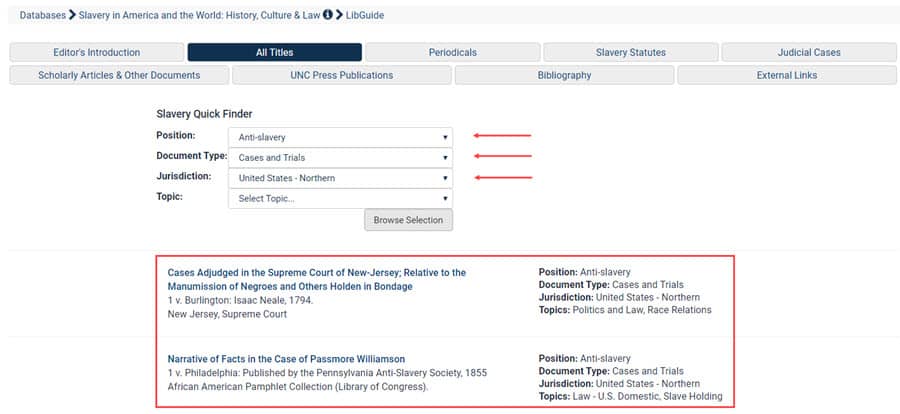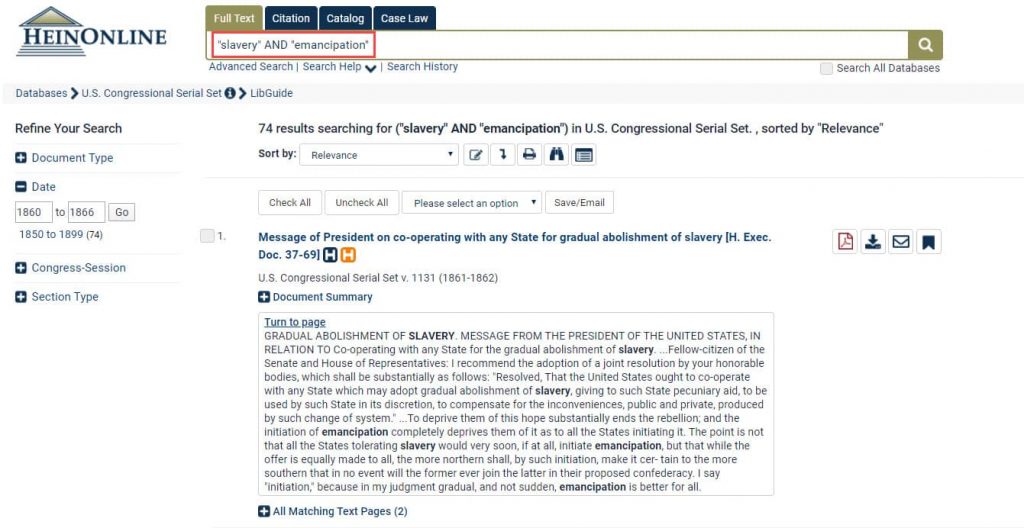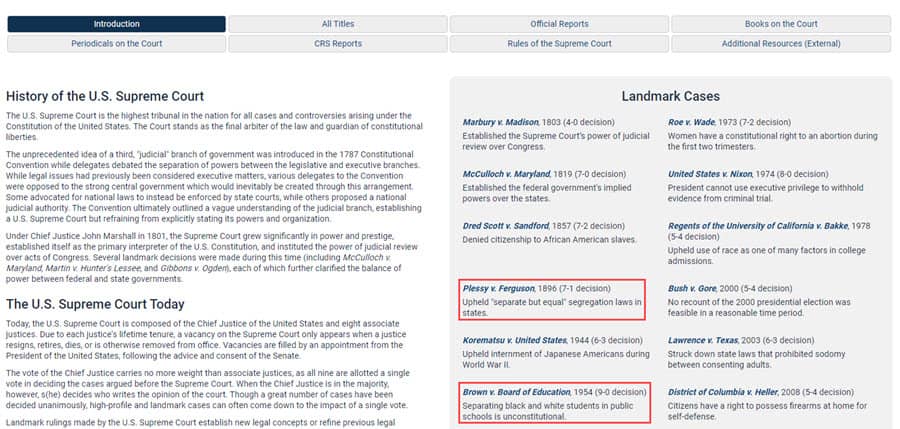Since the 1970s, the United States has dedicated the month of February to the observance of African American history. Chosen to commemorate the birthdays of Abraham Lincoln and Frederick Douglass, February serves as an annual opportunity to recognize the struggles and achievements of black Americans.
HeinOnline hopes its readers reflect on the contributions of African Americans all year; however, we particularly encourage users to spend this month immersing themselves in black history and the history of our nation—two areas of study forever intertwined.
Keep reading to discover five easy ways to jump into these vast topics in HeinOnline.
1. Use HeinOnline’s Slavery in America and the World to research the topic of slavery.
It is impossible to study black history in the United States without addressing the topic of slavery. To research this critical historical issue, HeinOnline has made its Slavery in America and the World database free to anyone with an interest in the subject: libraries, institutions, students, researchers, or any other entity within our global community.
Use this database to find all known legal materials on slavery in the United States and the English-speaking world. To get started, try the Slavery Quick Finder (located in the All Titles subcollection), which enables users to search for documents based on their position on slavery, type, jurisdiction, and topic. For instance, search for anti-slavery cases and trials from the northern United States:

Furthermore, with access to slavery statutes (at the state or federal level), judicial cases concerning slavery, numerous scholarly articles on the topic, and more, this database proves to be an essential resource for studying black history. Learn more about slavery, its end, and using HeinOnline’s Slavery database in this blog post.
If you haven’t already, register for free access to this monumental collection here. For more information on what’s included in the database, view our dedicated LibGuide below.
2. Dive into the U.S. Congressional Serial Set to learn about the Civil War and emancipation from primary sources.
Enslaved African Americans brought an abundance of cheap labor to the early North American colonies. Following the American Revolution, however, many Northerners began to reconsider slavery, viewing the oppressive practice as comparable to their own recent experience with the British. By the end of the 18th century, many Northern states had abolished slavery, yet the South still considered the practice vital to maintaining a thriving economy. Over the next few decades, this growing tension erupted into Southern secession and Civil War. By 1862, President Abraham Lincoln had issued a proclamation for the emancipation of more than 3.5 million enslaved African Americans.
To research this time period, users can turn to an indispensable historical resource—the U.S. Congressional Serial Set. The Serial Set is the official historical record of the U.S. government as it weathered every event in American history, including the pivotal period of the Civil War. The documents within record the words and actions of key players in the political life of the United States, and thus reflect the mindset of the era. From the landing page, perform a full-text search for keywords relating to the Civil War using relevant Boolean operators. See the results from the example slavery AND emancipation, shown below.

Relevant results include:
- Message of President on condition of States lately in rebellion
- Message of President on co-operating with any State for gradual abolishment of slavery
- Resolutions on slavery and the rebellion
- Tributes of nations upon assassination of President Lincoln
Try entering other keywords to see what you can find in this essential resource for the study of black history. For search help and other tips, check out the Serial Set LibGuide below.
3. Understand the doctrine of “separate but equal” with the U.S. Supreme Court Library.
In an attempt to regulate the behavior of freed slaves after the Civil War, states instituted laws that became known as Black Codes. These codes paved the way for Jim Crow Laws, state and local legislation which enforced racial segregation in public facilities, transportation, and schools. These laws were not challenged in court until the case of Plessy v. Ferguson in 1892; however, the U.S. Supreme Court ruled in favor of state-mandated segregation, provided it be “separate but equal.”
This ruling was eventually overturned by Brown v. Board of Education. After argument from Thurgood Marshall (later the first African American Supreme Court Justice), the Court voted unanimously that “in the field of public education the doctrine of ‘separate but equal’ has no place.” Segregated schools were determined to be “inherently unequal,” a decision that changed the course of U.S. education and black history. Learn more about the case in this blog post.
Quickly locate both landmark cases—Plessy v. Ferguson and Brown v. Board of Education—with ease in HeinOnline’s U.S. Supreme Court Library. On the database landing page, users will see an overview of the Supreme Court along with a list of the most-researched landmark cases in chronological order. Find both of these essential cases for studying African American history listed.

Check out a number of other ways to find Supreme Court cases in the database’s dedicated LibGuide.
4. Read about the efforts of Martin Luther King and the Civil Rights Movement in the Law Journal Library.
The struggle for African Americans did not end with Brown v. Board of Education. Racial discrimination and segregation remained legal, incorporated into the structure of other social systems and norms. After Brown, a movement for African American civil rights garnered national attention as citizens began to engage in nonviolent resistance, boycotts, sit-ins, and civil disobedience. Christian minister and activist Dr. Martin Luther King Jr. became known around the country for his work to advance civil rights, particularly after giving an eloquent speech on the struggles of black Americans.
King’s activism (among others’) fueled the civil rights movement, directly contributing to the passage of the Civil Rights Act of 1964. Originally proposed by President John F. Kennedy, the act prohibited discrimination, ended racial segregation, created equal employment opportunity, and more. Learn more about the passage of the act in this blog post.
Use HeinOnline’s Law Journal Library—a database of more than 2,700 law and law-related journals—to find a wealth of material relating to the civil rights movement. In the Advanced Search section of the database, users may enter a search term, select a topic, build a keyword or Venn diagram search, refine by date range, and much more. See an example that utilizes the Law Journal Library’s machine-learned topics to perform a relevant search in a flash.

Check out the LibGuide below to learn how to use the Law Journal Library’s other unique tools, including More Like This, Venn Diagram Search, ScholarCheck, and MyHein.
5. Find the words of Barack Obama, the first African American President, in the U.S. Presidential Library.
By the new millennium, an African American man had become the 44th president of the United States. His election raised hope for many Americans that the country’s history of racial tension would remain just that—history. However, during Obama’s presidency, activism against systemic racism and violence toward African Americans continued, as evidenced by the rise of Black Lives Matter (BLM). Rather than fully engaging with the movement, Obama called for unity, noting that concerns such as police brutality were not just “black” issues, but American.
At the end of his presidency, Obama admitted that the concept of a “post-racial America,” though well-intended, was an unrealistic one. Again calling for unification instead of divisiveness, he noted there is still much work to be done. Learn more about the presidency of Barack Obama in this blog post.
To find the text of Barack Obama’s own speeches, addresses, messages, and other documents, utilize the U.S. Presidential Library. The most comprehensive presidential collection ever available in digital format, the library holds more than 900 titles of documents relevant to every U.S. presidency. As just one example, head over to Public Papers of the Presidents of the United States and select Barack Obama.

Users will be directed to a list of Barack Obama’s public papers, organized into volumes by year. Select any year to view his public papers from that time. For example, select 2009 Book 1 to view public papers from Obama’s first months in office, shown below.

The U.S. Presidential Library holds much more than just the Public Papers of the Presidents. Find messages and papers of the presidents, daily and weekly compilations of presidential documents, documents relating to impeachment, Title 3 of the Code of Federal Regulations (CFR) and more. Learn more with the dedicated LibGuide below.
Like what you see and want more? Learn how to research a wealth of historical topics when you subscribe to the HeinOnline Blog. Follow the link below to subscribe today.



